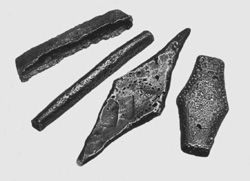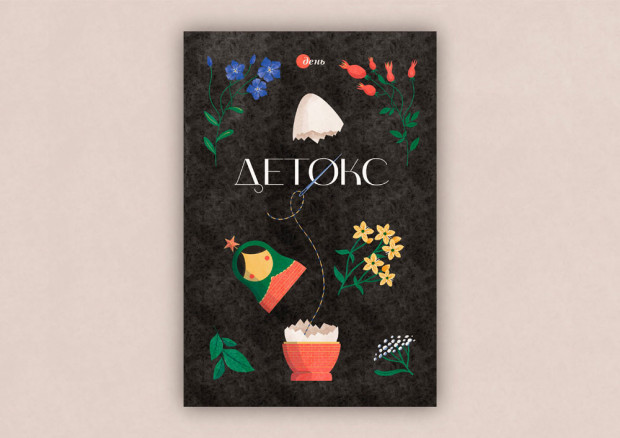HRYVNIA’S SECOND COMING

As historians claim, humanity invented money millennia before Christ. Since then, money has been and will always be ubiquitous. Commodity-money relations in Ukraine develop in a spiral relationship. The same happened to our hryvnia which only revived after Ukraine became an independent state. So when did the hryvnia emerge for the first time? Whence its name? How is it connected with historical traditions?
These and many other questions are being answered by Zinayida Zraziuk, Chair of the Numismatics Department, National Museum of Ukrainian History. “The history of the emergence of the hryvnia as a monetary unit dates back to the times of old Rus’. Kyivan Rus’ lacked its own money until the tenth century: it mostly used the Arabic silver dirhams which came to Rus’ territory through trade with the Caliphate. Rus’ merchants, who traded in the East in furs, wax, and cheliad (slaves), brought home dirhams which, hidden in troves, archeologists find in great quantities. Less frequently occur Byzantine gold solidi and silver semissis and tremissi and still more rarely European deniers. The spread of foreign coins in Kyivan Rus’ testifies to active trade and to the fact that foreign merchants found it safer to go across its territory than by sea.
However, the situation changed in the late tenth century. International ties and trade were being strengthened and expanded. Kyiv became capital of a large centralized state. It is then that Kyivan Rus begins to mint coins of its own for the first time in history, while the inflow of foreign coins ran dry for various reasons. For example, Arab dirhams vanish, as the Caliphate disintegrated, and its silver mines were exhausted.
The first, Rus’s proper, money — silver and gold coins (srebrenyky and zlatnyky) — emerged under Prince Volodymyr Sviatoslavovych, and were only minted for 25 years. Srebrenyky, made of imported silver, were issued under Volodymyr, Sviatopolk the Accursed, and when Yaroslav the Wise still reigned in Novgorod. But the zlatnyk, resembling the Byzantine solidus, was minted only in the times of Volodymyr, at the turn of the eleventh century. Yet, the reserves of the precious metal were not sufficient to issue the required quantity of coins. In addition, there were no private mints in Rus’ at that time. Sometimes, heads of European states granted monetary regalia, i.e., the right to mint coins, to some of their vassals: this was convenient for both suzerain and vassal. For minting is a very profitable business.
After Kyivan Rus’ had stopped issuing the zlotnyk and srebrenyk, it entered its so-called coin-free period. It is then that time that hryvnias came into being as large hunks of silver that could be weighed.
Let us turn to the very word, hryvnia. What immediately comes to mind is an old Rus’ ring-shaped ornament worn on the neck. Hence its being called hryvnia, for it was put on zahryvok, by the back of the neck. Kyivan smiths made neck hryvnias out of gold and silver. However, although the hryvnia seems to be a woman’s ornament, it was also worn by men, e.g., the prince and his retinue, as a symbol of authority. The neck hryvnia occurs both in burials and troves together with other ornaments such as bracelets and earrings. But it is not yet quite clear if there is any link between the hryvnia as a neck ornament and the coin hryvnia: the chronicles of the day provide no evidence.
The first hryvnias in Rus’ were of two kinds: the silver hryvnia, i.e., a silver ingot of a certain weight, and the hryvnia kun, a countable one consisting of a specific number of coins. Later on emerge the hryvnias one can see exhibited at Ukraine’s National History Museum. These hryvnias come from Kyiv, Novgorod, Chernihiv, and the Volga Basin. The earliest of them, from Kyiv, a hexagonal-shaped elongated silver piece weighing about 140-160 grams, appeared in the eleventh century. These hryvnias, the economic symbol of Kyiv, were in circulation until the Mongol-Tartar invasion in the thirteenth century.
Of great importance in Rus’ money circulation were the Novgorod hryvnias which emerged in northwestern Kyivan Rus’ and then spread throughout the state. Unlike those of Kyiv, Novgorod hryvnias were cast in the shape of little silver bars weighing about 204 grams. The Chernihiv hryvnia stood between those of Kyiv and Novgorod, resembling the former by shape and the latter by weight. The Chernihiv and Novgorod hryvnias got their geographic names according to where the archeologists found them, rather than the place they were cast. Also found on the territory of Ukraine were the Volga hryvnias made by ancient masters in the shape of a small boat.
In 1237, the 140,000-man army of Batu Khan, grandson of Genghis Khan, invaded Rus’. Kyiv was captured by the Mongols in the winter of 1240. Hryvnias gradually stopped circulating. The Kyiv hryvnia had vanished even earlier, in the early thirteenth century, while that of Novgorod existed until the fifteenth.
Old Rus’ hryvnias got a new lease of life as archeological finds. According to experts, Kyiv was one of the largest centers where hryvnias were concentrated: about 1/3 of all ancient Rus’ ingots weighing a total of about 130 kilograms were found by archeologists here. The troves most often feature Kyiv-type hryvnias and, somewhat more seldom, those of Novgorod and Chernihiv. It is important to remember, however, that a very amount of hryvnias have not reached us, for they were melted by jewelers in the late nineteenth century. Some hryvnias found their way to private coin collections, leaving us no information about them. The greatest concentration of hryvnias (as well as other old Rus’ finds) have been found in Kyiv’s Upper City and Podil (lower commercial suburb).
By the end of the fourteenth century, most of what is now known as Western Ukraine had become the domain of the Polish king, while the rest of lands, including Kyiv, belonged to the Grand Duke of Lithuania. Zinayida Zraziuk continues her story, noting the changes the hryvnia underwent in that period, “Our own coins were no longer minted, but there were some exceptions. For instance, the coins were minted under Volodymyr Olherdovych as late as 1394, when he was toppled from the Kyiv throne. Coins were also minted in Lviv on behalf of the Polish king.
The ruble emerged as an alternate name of the hryvnia issued as a silver ingot. By the fifteenth century, the hryvnia ingot, a.k.a. ruble ingot, had ceased to be legal tender, as the money mass was constantly growing and being devalued. Yet, it is the ruble based on the hryvnia that became the monetary unit of the Russian Empire and, later, the USSR.
The next revival of the hryvnia occurred owing to the Revolution of 1917. The Third Universal (decree) of November 20, 1917, proclaimed the Ukrainian People’s Republic (UNR) and Fourth Universal on January 22, 1918, full independence. Soon after the hryvnia was made the UNR’s main currency by the Central Rada on March 3, 1918, with the ruble (karbovanets) remaining a transitional currency. The ruble-to-hryvnia exchange rate was one to two. Moreover, the new paper hryvnia could not be supported by the young republic’s gold reserves.
“But the Ukrainian hryvnia of 1918,” Ms. Zraziuk continues, “bore the inscription ‘ensured by the whole state property of the Republic’ instead of the customary phrase ‘ensured by the country’s gold reserve.’ To strengthen the economy and the new monetary unit, the state declared its monopoly on vodka, tobacco, and sugar. In addition, the UNR government opened the Land Bank, where land could be acquired, and began to issue bonds. These measures resulted in the hryvnia’s stability until mid-1918, when public unrest shook its position. However, despite the official decree of 1918, the hryvnia remained in circulation until 1920.”
This is history. As to the hryvnia’s second coming caused by Ukraine regaining the status of an independent state, it occurred as a result of the continuity of historical traditions.
№17 May 30 2000 «The
Day»
In using our publications, reference to The Day is
mandatory. © "День"






